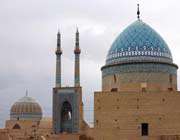Different Stages in Development of Iranian Tile’s Works
Before tile work, as we know today, became popular brick and stucco were most important in decoration of buildings up to 10-11th A.D.
Two mosques of Na"in and Neiriz have brick decoration in geometric patterns of the Buyid period. By 11-12th A.D., brick decoration had spread from the east throughout Iran. The best examples of brick decoration of this period are the mausoleums of Pir Alamadar, 1026 A.D., Chehel Dokhtaran, 466 A.D., and the Tower of Mihmandost 1096 A.D.
The next stage of development was the use of colored glaze on decorative brick; turquoise being the most popular color.
Pieces of turquoise glazed bricks were used with decorative brick works on monuments from the Saljuq period onwards.
So artisans were familiar with the technique of manufacture of glazed bricks by this time. Sometimes these turquoise glazed bricks were used to create Kufic inscription among the brick patterns or were scattered among the brick patterns.
The earliest example unfired turquoise Kufic inscription, is a panel stored at Iran Bastan Museum (National Museum of Iran) ascribed to the end of the 10-11th A.D.
Other religious structures which have turquoise tile works are Seyed Mosque, Isfahan, 1122 A.D., the red Dome of Maraqeh 1147 A.D. and the Jame Mosque of Gonabad 1212 A.D.
Mongol invasion slowed and halted many artistic traditions and trends. Normal conditions only returned by the 13th century A.D., when the Ilkhanid rulers accepted Islam; they also became interested in creating secular and non-secular monuments and buildings. By this time, decorative bricks and tiles were used not only on the exterior, but also inside the building to cover the walls and domes.
The art of tile manufacture reached its highest point of perfection and beauty at the end of Ilkhanid period and the beginning of Timurid in the form of Moraq tiles (mosaic style).

Tile panels created with this technique are very durable and could withstand the elements of time. Here, tiles in such colors as yellow, blue, brown, black, turquoise, green and white were cut and carved into small pieces according to a previously prepared pattern. These pieces were placed close together and liquid plaster poured over to fill in all the opening and gaps. After the plaster dried and hardened, a large single piece tile panel had been created, which was then plastered onto the required wall of the building. Timurid monuments in Herat, Samarkand and Bukhara were covered by this decorative technique. Among the most famous monuments so decorated are Goharshad Mosque (1418 AD.), Molana Mosque (1444 AD.), Jame Mosque of Yazd (1456 AD.), Jame Mosque of Varamin (1322 AD.) and Madrasa of Khan in Shiraz (1615 AD.)
Other links:
HISTORY OF ROMAN ARCHITECTURE
GREECE ARCHITECHTURE
Chinese Architecture